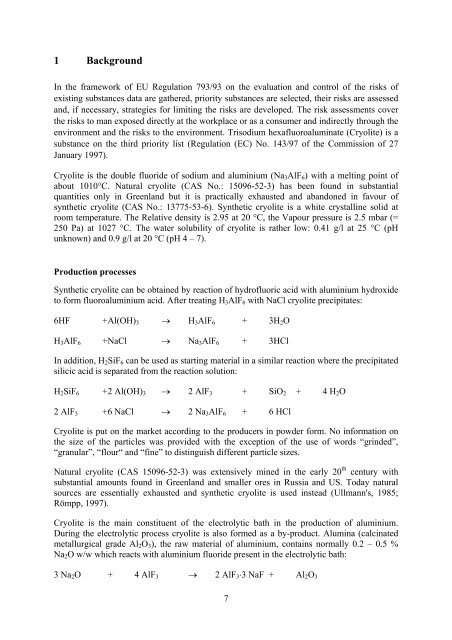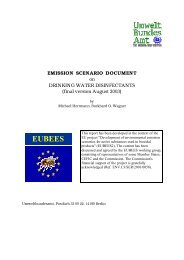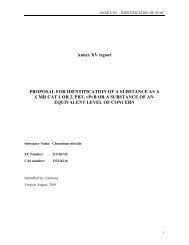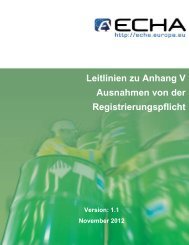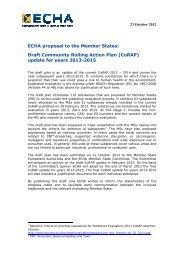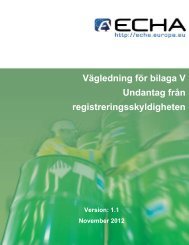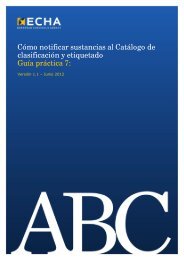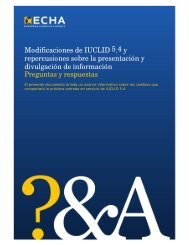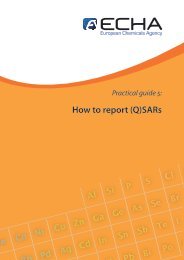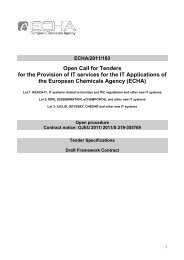Strategy For Limiting Risks Human Health Draft of ... - ECHA - Europa
Strategy For Limiting Risks Human Health Draft of ... - ECHA - Europa
Strategy For Limiting Risks Human Health Draft of ... - ECHA - Europa
You also want an ePaper? Increase the reach of your titles
YUMPU automatically turns print PDFs into web optimized ePapers that Google loves.
1 Background<br />
In the framework <strong>of</strong> EU Regulation 793/93 on the evaluation and control <strong>of</strong> the risks <strong>of</strong><br />
existing substances data are gathered, priority substances are selected, their risks are assessed<br />
and, if necessary, strategies for limiting the risks are developed. The risk assessments cover<br />
the risks to man exposed directly at the workplace or as a consumer and indirectly through the<br />
environment and the risks to the environment. Trisodium hexafluoroaluminate (Cryolite) is a<br />
substance on the third priority list (Regulation (EC) No. 143/97 <strong>of</strong> the Commission <strong>of</strong> 27<br />
January 1997).<br />
Cryolite is the double fluoride <strong>of</strong> sodium and aluminium (Na3AlF6) with a melting point <strong>of</strong><br />
about 1010°C. Natural cryolite (CAS No.: 15096-52-3) has been found in substantial<br />
quantities only in Greenland but it is practically exhausted and abandoned in favour <strong>of</strong><br />
synthetic cryolite (CAS No.: 13775-53-6). Synthetic cryolite is a white crystalline solid at<br />
room temperature. The Relative density is 2.95 at 20 °C, the Vapour pressure is 2.5 mbar (=<br />
250 Pa) at 1027 °C. The water solubility <strong>of</strong> cryolite is rather low: 0.41 g/l at 25 °C (pH<br />
unknown) and 0.9 g/l at 20 °C (pH 4 – 7).<br />
Production processes<br />
Synthetic cryolite can be obtained by reaction <strong>of</strong> hydr<strong>of</strong>luoric acid with aluminium hydroxide<br />
to form fluoroaluminium acid. After treating H3AlF6 with NaCl cryolite precipitates:<br />
6HF + Al(OH)3 → H3AlF6 + 3H2O<br />
H3AlF6 + NaCl → Na3AlF6 + 3HCl<br />
In addition, H2SiF6 can be used as starting material in a similar reaction where the precipitated<br />
silicic acid is separated from the reaction solution:<br />
H2SiF6 + 2 Al(OH)3 → 2 AlF3 + SiO2 + 4 H2O<br />
2 AlF3 + 6 NaCl → 2 Na3AlF6 + 6 HCl<br />
Cryolite is put on the market according to the producers in powder form. No information on<br />
the size <strong>of</strong> the particles was provided with the exception <strong>of</strong> the use <strong>of</strong> words “grinded”,<br />
“granular”, “flour“ and “fine” to distinguish different particle sizes.<br />
Natural cryolite (CAS 15096-52-3) was extensively mined in the early 20 th century with<br />
substantial amounts found in Greenland and smaller ores in Russia and US. Today natural<br />
sources are essentially exhausted and synthetic cryolite is used instead (Ullmann's, 1985;<br />
Römpp, 1997).<br />
Cryolite is the main constituent <strong>of</strong> the electrolytic bath in the production <strong>of</strong> aluminium.<br />
During the electrolytic process cryolite is also formed as a by-product. Alumina (calcinated<br />
metallurgical grade Al2O3), the raw material <strong>of</strong> aluminium, contains normally 0.2 – 0.5 %<br />
Na2O w/w which reacts with aluminium fluoride present in the electrolytic bath:<br />
3 Na2O + 4 AlF3 → 2 AlF3⋅3 NaF + Al2O3<br />
7


